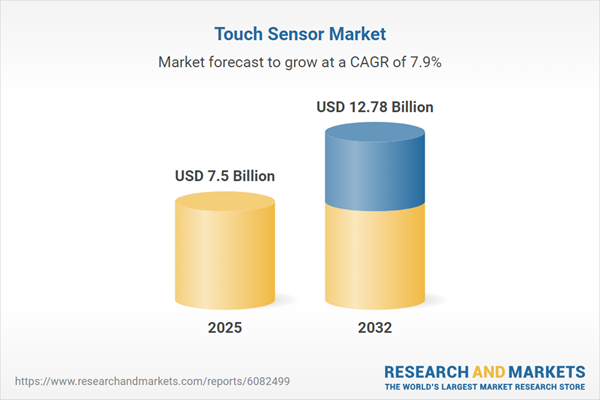Speak directly to the analyst to clarify any post sales queries you may have.
Touch sensing technology empowers organizations to enhance digital engagement across sectors through responsive, adaptive user interfaces. As industries seek competitive differentiation amid rapid technology cycles and rising user expectations, leaders require actionable insights to inform strategic planning in the evolving touch sensor market.
Market Snapshot: Touch Sensor Market Growth and Trends
The Touch Sensor Market demonstrated measurable momentum, expanding from USD 6.95 billion in 2024 to USD 7.50 billion in 2025, with expectations to achieve a CAGR of 7.90% and reach USD 12.78 billion by 2032.
Sustained investment arises as sectors—including automotive, consumer electronics, healthcare, and industrial automation—prioritize seamless, intuitive digital experiences. Adoption of edge computing, robust IoT integration, and heightened demand for tactile responsiveness are driving technology innovation. These trends reshape competition, compelling organizations to adapt product portfolios to serve shifting market preferences and end-user demands.Scope & Segmentation of the Touch Sensor Market
- Technology Types: Capacitive, infrared, optical, and resistive sensors, including mutual and self-capacitive, five wire, four wire, surface resistive, as well as surface acoustic wave variants, fulfill differing operational needs for responsiveness, durability, and environmental resistance.
- End Use Sectors: Touch sensors are integrated in aerospace (e.g., avionics displays), automotive (instrument clusters, infotainment), consumer electronics (smartphones, tablets, laptops), healthcare (medical devices, surgical apparatus), and industrial automation (SCADA systems, human machine interfaces). Each vertical benefits from greater user interface precision and reliability tailored to specific operational environments.
- Panel Types: Multi-touch variants—such as five-point and above, three-dimensional, and two-point capabilities—combine with single-touch panels to address applications from complex user interaction to straightforward functional control.
- Mounting Methods: In-cell, on-cell, and on-panel integration methods influence design freedom, display clarity, and streamline assembly processes for manufacturers.
- Sales Channels: Distribution via original equipment manufacturers (OEM) and aftermarket suppliers enables both new equipment integration and retrofitting projects to improve interfacing within legacy systems.
- Geographic Coverage: Analysis spans the Americas, Europe, the Middle East & Africa, and Asia-Pacific, considering regulatory diversity and market maturity for comprehensive regional strategies.
- Key Companies Profiled: Competitive landscape review includes strategies and innovations from Honeywell International Inc., Infineon Technologies AG, Abatek International AG, Siemens AG, Renesas Electronics Corporation, Banpil Photonics, Inc., Microchip Technology Incorporated, Qualcomm Technologies, Inc., STMicroelectronics NV, and Texas Instruments Incorporated, reflecting leading market dynamics.
Key Takeaways for Strategic Decision-Making
- Touch sensing technology underpins digital transformation initiatives by enabling advanced material integration, miniaturized component design, and precise signal processing, all supporting operational optimization.
- Successful geographic expansion relies on agile, region-specific go-to-market models and a nuanced understanding of regulatory variations and user needs in target markets.
- Growth in wearables and automotive applications brings innovation in substrate flexibility and high-resolution multi-touch functionality, extending the scope of end-user solutions.
- Sustainability considerations now inform R&D investment and procurement planning, as long-term product lifecycles and environmental impact become central selection criteria.
- Development of software-defined sensor ecosystems delivers adaptable interfaces, predictive maintenance capabilities, and enhancements in hardware-centric cybersecurity, helping organizations future-proof deployments.
- Collaborative partnerships between established players and emerging technology firms are accelerating the commercialization of flexible, transparent, and next-generation touch sensor solutions.
Tariff Impact and Supply Chain Realignment
Recent tariff developments in the United States have prompted sector-wide supply chain adjustments. Organizations are shifting toward diversified sourcing, bolstering local manufacturing, and seeking cost efficiencies to minimize exposure to policy risk. Engaging with suppliers in emerging markets and adjusting internal R&D priorities supports resilience and maintains market momentum for touch sensing technology.
Methodology & Data Sources
Findings are grounded in primary research, leveraging executive interviews and direct input from technical leaders and procurement officers, complemented by secondary research from established industry outlets, patent databases, and trade publications. Quantitative outcomes are validated by examining shipment data, trade records, and vetted financial statements, cross-checked by subject-matter experts.
Why This Report Matters
- Delivers pragmatic, actionable insights into emerging touch sensor innovations, detailed segmentation, and evolving go-to-market strategies for solid, sustainable growth.
- Clarifies how shifting regulatory environments and evolving regional opportunities impact executive priorities and risk management planning.
- Supports informed decision-making in investment planning and strategic response to ongoing supply chain evolution and policy change.
Conclusion
The Touch Sensor Market presents continual opportunities for innovation and targeted execution. This report enables strategic leaders to synthesize complexity, anticipate disruptions, and drive resilient, technology-forward outcomes.
Table of Contents
3. Executive Summary
4. Market Overview
7. Cumulative Impact of Artificial Intelligence 2025
Companies Mentioned
The companies profiled in this Touch Sensor market report include:- Honeywell International Inc.
- Infineon Technologies AG
- Abatek International AG
- Siemens AG
- Renesas Electronics Corporation.
- Banpil Photonics, Inc.
- Microchip Technology Incorporated
- Qualcomm Technologies, Inc.
- STMicroelectronics NV
- Texas Instruments Incorporated
Table Information
| Report Attribute | Details |
|---|---|
| No. of Pages | 189 |
| Published | October 2025 |
| Forecast Period | 2025 - 2032 |
| Estimated Market Value ( USD | $ 7.5 Billion |
| Forecasted Market Value ( USD | $ 12.78 Billion |
| Compound Annual Growth Rate | 7.9% |
| Regions Covered | Global |
| No. of Companies Mentioned | 11 |









